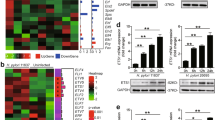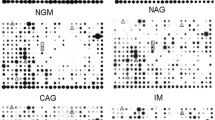Abstract
Purpose
Stomach cancer has a high mortality rate in East Asia, and is strongly associated with Helicobacter pylori (H. pylori) infection. H. pylori is known to express chemokine genes in the gastric mucosa, chemokines that are important host immune factors facilitating inflammation and tumor growth. To investigate the mechanism of carcinogenesis in the stomach, it is essential to determine which molecule of H. pylori is involved in induction of chemokines, but this has remained unclear. We previously reported that a tumor necrosis factor-α (TNF-α) inducing protein (Tipα) secreted from H. pylori acts as a tumor promoter in stomach cancer development, and thus started to investigate whether Tipα is involved in induction of chemokine genes.
Methods
Comprehensive gene expression analysis was conducted using DNA microarray and KeyMolnet analyses. The gene expression was quantitatively analyzed by real-time RT-PCR.
Results
Comprehensive and quantitative gene expression analyses revealed that Tipα induces gene expression of the chemokines Ccl2, Ccl7, Ccl20, Cxcl1, Cxcl2, Cxcl5 and Cxcl10 extensively and simultaneously in mouse stomach cancer cells, MGT-40. Tipα induced high levels of chemokine gene expression, whereas inactive deleted Tipα, del-Tipα, showed only marginal expression, suggesting a correlation between tumor promotion and chemokine gene expression by Tipα. MG-132, a proteasome inhibitor which represses NF-κB-activation, inhibited chemokine gene expressions.
Conclusion
We report here that Tipα of H. pylori gene product is a strong inducer of chemokine gene expressions, providing a new model for stomach cancer development.






Similar content being viewed by others
References
Balkwill F (2004) Cancer and the chemokine network. Nat Rev Cancer 4:540–550
De Valck D, Jin DY, Heyninck K, Van de Craen M, Contreras R, Fiers W, Jeang KT, Beyaert R (1999) The zinc finger protein A20 interacts with a novel anti-apoptotic protein which is cleaved by specific caspases. Oncogene 18:4182–4190
Eaton KA, Kersulyte D, Mefford M, Danon SJ, Krakowka S, Berg DE (2001) Role of Helicobacter pylori cag region genes in colonization and gastritis in two animal models. Infect Immun 69:2902–2908
Franco AT, Israel DA, Washington MK, Krishna U, Fox JG, Rogers AB, Neish AS, Collier-Hyams L, Perez-Perez GI, Hatakeyama M, Whitehead R, Gaus K, O’Brien DP, Romero-Gallo J, Peek RM Jr (2005) Activation of β-catenin by carcinogenic Helicobacter pylori. Proc Natl Acad Sci USA 102:10646–10651
Fujiki H, Suganuma M, Okabe S, Kurusu M, Imai K, Nakachi K (2002) Involvement of TNF-α changes in human cancer development, prevention and palliative care. Mech Ageing Dev 123:1655–1663
Haslett JN, Sanoudou D, Kho AT, Bennett RR, Greenberg SA, Kohane IS, Beggs AH, Kunkel LM (2002) Gene expression comparison of biopsies from duchenne muscular dystrophy (DMD) and normal skeletal muscle. Proc Natl Acad Sci USA 99:15000–15005
Hatakeyama M (2004) Oncogenic mechanisms of the Helicobacter pylori CagA protein. Nat Rev Cancer 4:688–694
Hu MC, Hung MC (2005) Role of IkappaB kinase in tumorigenesis. Future Oncol 1:67–78
IARC (1994) Working group on the evaluation of carcinogenic risks to humans. Lyon IARC 61:177–240
Ichinose M, Nakanishi H, Fujino S, Tatematsu M (1998) Establishment and characterization of two cell lines from N-methyl-N-nitrosourea-induced mouse glandular stomach carcinomas. Jpn J Cancer Res 89:516–524
Jin DY, Spencer F, Jeang KT (1998) Human T cell leukemia virus type 1 oncoprotein tax targets the human mitotic checkpoint protein MAD1. Cell 93:81–91
Kluver E, Adermann K, Schulz A (2006) Synthesis and structure-activity relationship of β-defensins, multi-functional peptides of the immune system. J Pept Sci 12:243–257
Liou HC, Hsia CY (2003) Distinctions between c-Rel and other NF-κB proteins in immunity and disease. Bioessays 25:767–780
Lu H, Wu JY, Kudo T, Ohno T, Graham DY, Yamaoka Y (2005) Regulation of interleukin-6 promoter activation in gastric epithelial cells infected with Helicobacter pylori. Mol Biol Cell 16:4954–4966
Nagasawa M, Kanzaki M, Iino Y, Morishita Y, Kojima I (2001) Identification of a novel chloride channel expressed in the endoplasmic reticulum, golgi apparatus, and nucleus. J Biol Chem 276:20413–20418
Peek Jr RM, Blaser MJ (2002) Helicobacter pylori and gastrointestinal tract adenocarcinoma. Nat Rev Cancer 2:28–37
Resnick MB, Sabo E, Meitner P, Kim SS, Cho Y, Kim H, Tavares R, Moss SF (2006) Global analysis of the human gastric epithelial transcriptome altered by H. pylori eradication in vivo. Gut May 24
Richmond A (2002) NF-κB, chemokine gene transcription and tumour growth. Nat Rev Immunol 2:664–674
Sato H, Ishida S, Toda K, Matsuda R, Hayashi Y, Shigetaka M, Fukuda M, Wakamatsu Y, Itai A (2005) New approaches to mechanism analysis for drug discovery using DNA microarray data combined with KeyMolnet. Curr Drug Discov Technol 2:89–98
Sendera TJ, Dorris D, Ramakrishnan R, Nguyen A, Trakas D, Mazumder A (2002) Expression profiling with oligonucleotide arrays: technologies and applications for neurobiology. Neurochem Res 27:1005–1026
Suganuma M, Kurusu M, Okabe S, Sueoka N, Yoshida M, Wakatsuki Y, Fujiki H (2001) Helicobacter pylori membrane protein 1: a new carcinogenic factor of Helicobacter pylori. Cancer Res 61:6356–6359
Suganuma M, Kurusu M, Suzuki K, Nishizono A, Murakami K, Fujioka T, Fujiki H (2005) New tumor necrosis factor-alpha-inducing protein released from Helicobacter pylori for gastric cancer progression. J Cancer Res Clin Oncol 131:305–313
Suganuma M, Kuzuhara T, Yamaguchi K, Fujiki H (2006) Carcinogenic role of tumor necrosis factor-alpha inducing protein of Helicobacter pylori in human stomach. J Biochem Mol Biol 39:1–8
Toyoda H, Komurasaki T, Uchida D, Takayama Y, Isobe T, Okuyama T, Hanada K (1995) Epiregulin. A novel epidermal growth factor with mitogenic activity for rat primary hepatocytes. J Biol Chem 270:7495–7500
Visapaa I, Fellman V, Lanyi L, Peltonen L (2002) ABCB6 (MTABC3) excluded as the causative gene for the growth retardation syndrome with aminoaciduria, cholestasis, iron overload, and lactacidosis. Am J Med Genet 109:202–205
Wasmuth HE, Glantz A, Keppeler H, Simon E, Bartz C, Rath W, Mattsson LA, Marschall HU, Lammert F (2006) Intrahepatic cholestasis of pregnancy: the severe form is associated with common variants of the hepatobiliary phospholipid transporter gene ABCB4. Gut Aug 4
Acknowledgments
We thank Drs. Yuichi Kikushima, Hiromi Sato, and Akiko Itai at Institute of Medicinal Molecular Design, Inc. (IMMD) to conduct KeyMolnet analysis of the DNA microarray data. We thank Dr. Masae Tatematsu for his kind gift of MGT-40 cells and Dr. Midori Suenaga for a fruitful discussion. We also thank Kurabo Co. Ltd., Ms. Kinuko Sasada, Ms. Mitsuyo Kato, Ms. Yukari Nagata, Mr. Ryoji Sugiyama, Ms. Jyuri Tateishi and Mr. Tairo Shiraishi for their skillful technical assistance. This work was supported in part by Grants-in-Aid for Scientific Research from the Ministry of Education, Culture, Sports, Science and Technology, Japan, and the Smoking Research Fund.
Author information
Authors and Affiliations
Corresponding author
Rights and permissions
About this article
Cite this article
Kuzuhara, T., Suganuma, M., Kurusu, M. et al. Helicobacter pylori-secreting protein Tipα is a potent inducer of chemokine gene expressions in stomach cancer cells. J Cancer Res Clin Oncol 133, 287–296 (2007). https://doi.org/10.1007/s00432-006-0169-6
Received:
Accepted:
Published:
Issue Date:
DOI: https://doi.org/10.1007/s00432-006-0169-6




